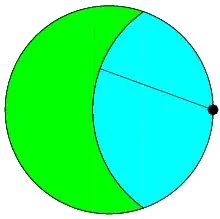This year, there was published a closed-form solution to the Goat Problem. The problem seeks the radius of a circle (teal) with center on the edge of a unit circle (green) such that the first circle overlaps half of the unit circle.
The solution given is
$$r=2\cos\left(\frac{{\Large\oint}_{\large|z-3\pi/8|=\pi/4}{\Large\frac{z}{\sin{z}-z\cos{z}-\pi/2}}dz}{{\Large\oint}_{\large|z-3\pi/8|=\pi/4}{\Large\frac{2}{\sin{z}-z\cos{z}-\pi/2}}dz}\right)= 1.15872847\dots$$
Can we simplify this further? I noticed that the divided integrals look like a center of mass formula. I tried converting the contour integrals into real integrals, but didn't get very far. I don't have much experience with complex integration. Also, I don't have access to the paper, but maybe there is some information there that can help us.
